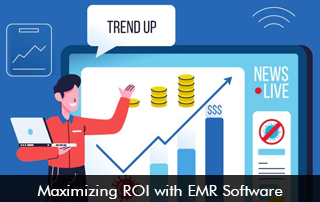The utilization of EMR software goes beyond mere patient record-keeping. When leveraged effectively, it can yield a significant return on investment (ROI) for clinics and hospitals alike. This includes specialized practices in fields like gastroenterology and neurology, where specific EMR software solutions can fine-tune efficiencies. In this comprehensive guide, we’ll explore how to maximize the ROI with EMR software, ensuring that your investment pays dividends in patient care, workflow enhancement, and financial performance.
Understanding EMR Software
EMR software is a digital system that replaces traditional paper records. It allows for the electronic storage, retrieval, and modification of patient health information. A robust EMR system is an integral component of any modern medical practice, providing benefits such as improved patient care, streamlined workflows, and enhanced data security.
Specialized EMR Solutions
For specialized practices, such as gastroenterology and neurology, there are tailored EMR solutions available. These specialized systems, such as gastroenterology EMR software and neurology EMR software, are designed with the unique needs of these fields in mind. They include custom templates for patient exams, procedure reports, and specific workflow optimizations that cater to the intricacies of each specialty.
Key Benefits of EMR Software
Improved Patient Care
The primary purpose of healthcare is to provide quality patient care, and EMR software significantly contributes to this goal. With instant access to patient histories, treatments, and test results, healthcare providers can make informed decisions more quickly, leading to better patient outcomes.
Increased Efficiency
EMR systems streamline administrative tasks such as scheduling, billing, and compliance reporting. This leads to reduced overhead costs and allows medical staff to focus more on patient care rather than paperwork.
Enhanced Data Security
In comparison to paper records, EMR software offers superior data protection with features like access controls, encryption, and secure data backup, ensuring patient information remains confidential and safe from unauthorized access.
Strategies for Maximizing ROI With EMR Software
To realize the full potential of your EMR investment, it’s essential to implement strategies that enhance its utility and impact on your practice’s bottom line.
Tailoring EMR Software to Your Practice
When selecting an EMR system, it’s critical to choose one that aligns with your specific practice needs. Gastroenterology and neurology practices, for example, should look for EMR software that offers specialty-specific features. This ensures that the system enhances, rather than hinders, daily operations.
Optimizing Workflows
The true value of EMR software lies in its ability to optimize your practice’s workflows. By customizing the software to fit your processes, you can eliminate unnecessary steps and automate routine tasks, thereby increasing efficiency and reducing costs.
Leveraging Data Analytics
EMR software can serve as a goldmine of data, providing insights into practice patterns, patient outcomes, and financial performance. By analyzing this data, practices can identify areas for improvement and make data-driven decisions that enhance ROI.
Ensuring Staff Training and Adoption
The success of EMR software is contingent on its adoption by your entire team. Invest in comprehensive training programs to ensure that all staff members are proficient in using the system. This will lead to better utilization and a quicker realization of its benefits.
Fostering Patient Engagement
EMR systems often come with patient portals that can empower patients to take a more active role in their healthcare. By encouraging patients to use these portals for appointments, prescription refills, and communication, you can improve patient satisfaction and retention, positively impacting ROI.
Regularly Assessing Performance
Implementing an EMR system is not a set-it-and-forget-it solution. Regular assessments are necessary to ensure that the software continues to meet the evolving needs of your practice and the healthcare industry.
Real-World Impact of EMR Software on ROI
Case Studies
Several practices have witnessed the tangible benefits of EMR software on their ROI. For instance, a gastroenterology practice may use its EMR system to reduce no-show rates by implementing automated appointment reminders, resulting in increased revenue. Similarly, a neurology clinic could streamline complex medication management through EMR integration, saving time and reducing errors.
Choosing the Right EMR Software
The market is flooded with EMR solutions, each promising a range of features and benefits. Here are some considerations to keep in mind when selecting the right EMR software for your practice:
Specialty-Specific Features
Ensure that the EMR software offers templates and workflows that are specifically designed for your field, whether it’s gastroenterology, neurology, or another specialty.
Scalability
Your chosen EMR system should be able to grow with your practice. Consider the scalability of the software and whether it can accommodate an increasing number of patients, providers, and locations.
Integration Capabilities
The ability to integrate with other systems, such as practice management software and billing services, is crucial for a seamless workflow and maximized ROI.
Vendor Support and Training
Evaluate the level of support and training provided by the EMR vendor. Strong vendor support can significantly influence the successful implementation and ongoing optimization of the software.
Cost Considerations
While cost should not be the sole determining factor, it is important to assess the total cost of ownership, including initial implementation expenses, ongoing fees, and potential savings.
Implementing EMR Software for ROI Success
Implementing EMR software in your practice is a significant step that requires careful planning and execution. Here are some best practices to ensure a successful implementation:
Involving Key Stakeholders
Engage with physicians, nurses, administrative staff, and IT professionals from the outset to gather input and build consensus around the EMR implementation.
Planning for Transition
Develop a detailed plan for the transition from paper records to the EMR system, including timelines, training schedules, and contingency plans.
Monitoring Progress
Set up metrics to monitor the progress of EMR implementation and its impact on practice operations. Adjust strategies as necessary to address any challenges that arise.
Celebrating Milestones
Recognize and celebrate milestones achieved during the EMR implementation process to maintain momentum and morale among the staff.









